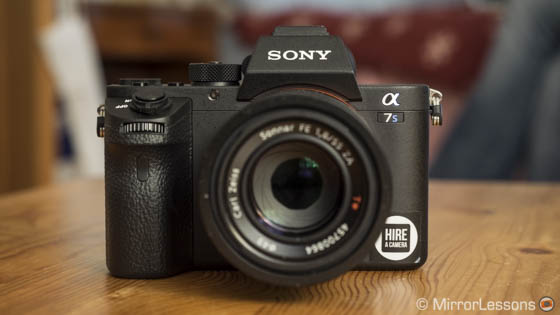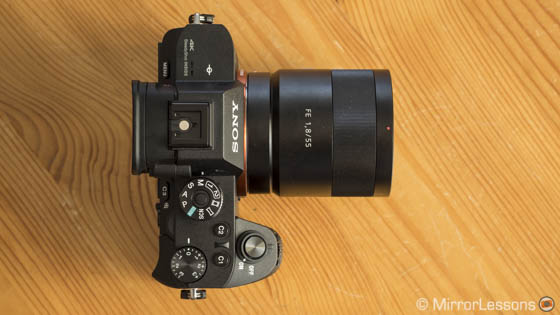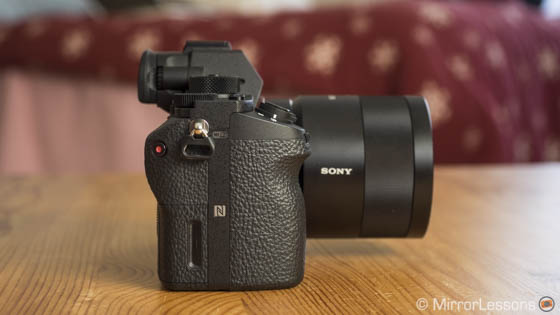Testing a camera in the right environment and on the right occasion can definitely help you carry out a more complete analysis, even if you don’t spend that much time with it. This is what happened over this year’s Halloween weekend here in Wales. Given the great low-light capabilities of the first Sony A7s, there couldn’t have been a better chance to review its successor, the Sony A7s II!
For a camera tester, the nice thing about the A7s II is that it is similar in many ways to the other Sony A7 mark II cameras. This lets me skip a few aspects such as design, ergonomics and ease of use that I’d already covered in other articles. The A7s II didn’t feel at all new in my hands. The only thing I had to do was copy the same settings I’d customised on my A7r II and voilà: I started using the camera with the feeling that I’d already owned it for months. If you are curious to know more about the design and ease of use, I summarised all my thoughts in my recent A7r II vs A7s II comparison article and in the 4 pictures below.
With the new A7s mark II, my main goal was to understand whether the camera is still worth the money for its low light capabilities now that Sony has updated the entire A7 series.
Sony A7s mark II Main Specs
- Sensor: 12 megapixel 35mm full frame Exmor CMOS
- Lens system: e-mount
- Weatherproof: Partial (Splash and dust proof)
- Internal Stabilisation: Yes (5-axis)
- Autofocus: Contrast detection AF with 169 contrast detection areas
- Continuous shooting: 5 fps (Speed), 2.5fps (focus)
- ISO Sensitivity: 100 – 102400 ISO (extended 50, 204800 and 409600)
- Shutter Speeds: 1/8000 to 30 seconds
- Viewfinder: XGA OLED electronic viewfinder with 2,359k dots, approx. 100% FOV coverage and 0.78x magnification
- LCD Screen: articulated 3″ LCD monitor (1,228k dots)
- Movie recording: XAVC S 4K up to 30fps, Full HD up to 60fps and 120fps in 720p
- Built-in Flash: No
- Extra Features: WiFi, NFC, Panorama, HDR, Multiple exposure, S-log2
- Dimensions: 126.9 x 95.7 x 60.3mm
- Weight: 627g (including battery and memory card)
[toc heading_levels=”3″]
Steam, Scream and the Big Waves
Friday night was the first Halloween event at the Talyllyn railway. You might have already seen lots of pictures of this railway in our articles since we moved to Wales. It is definitely one of the most interesting things to photograph in the area and the railway is always active with many events. Given the fact that it is run by volunteers, they really do a fantastic job. For this October weekend, families could book a meal and a ride on the train to the Nant Gwernol falls. Many of the volunteers entertained the kids with different costumes, funny tricks and stories. A special mention goes out to fellow photography lover Kyle for his extremely scary clown costume!

This first night, I took a few high ISO shots but mainly concentrated on recording video footage.
The first A7s already had amazing low-light performance and despite the good still capabilities, it had the most success among filmmakers. The new A7s II is no exception. While it keeps the same 12MP CMOS full frame sensor, it gets a few welcome improvements. The major upgrade is the internal 4K recording (XAVC S codec, 100 or 60mbps) at 24, 25 or 30fps depending on whether you choose NTSC/PAL. The camera also has a Super 35/APS-C crop mode but unlike the A7r II, it gives its best performance in full-frame mode where the camera records with full pixel readout without pixel binning (aka no aliasing or moiré issues).
At the Tywyn Wharf station, I switched between 1600 ISO and 12800 but most of the time the latter value was my sweet spot. The footage is so clean that it allowed me to adjust my aperture as I wished while keeping the standard 1/50s shutter speed for 25p recording.

I used the Sigma 35mm f/1.4 Art and the Sony Zeiss 55mm f/1.8. With the former I relied on the magnification assist most of the time to double check my focus point. The only disappointment is that like the A7r II, the resolution of the EVF decreases a little when activated. The peaking is not good enough and that is something I’ve noticed since the first generation of A7 cameras. I usually set it to low or middle depending on the situation and I prefer the yellow colour but I don’t trust it completely. The electronic viewfinder is the same as the A7r II. In some cases I even find it good enough to manually focus without any MF assists.
Sometimes a clearer view without too many elements displayed on the EVF makes it easier to manually focus precisely while peaking can sometimes be confusing.
With the 55mm I used both continuous and Manual Focus. The former is not bad as long as your subject doesn’t get too close, moves slowly and is within a short distance. Otherwise the camera will have a hard time keeping it in focus. The A7s II also hunted on several occasions, especially when there were specular highlights in the background. If you half press the shutter button to refocus when the camera has trouble tracking, there is lot of back and forth movement for 3 or 4 seconds before it locks the focus point. Sony also continues to not give us Single-AF in movie mode. Instead all we get is Continuous AF.
We decided not to travel on the train but “follow” it with the car so that we could film it from different positions. We drove to Dolgoch station, the halfway point, which was definitely a darker location. I had time to shoot a few decorations set up for the event before the train arrived.

Click on the image to open the full res version.
For most of my shots I used a customised picture profile (PP1) where I set the Cine1 gamma and Cinema Color mode. Throughout the weekend I refined this profile to match my taste. The picture profiles for video on these Sony cameras are excellent and if you take the time to find the right settings, you can get excellent results out of the camera. In my case of course I could apply from the start some experience I’d gathered from the previous A7 cameras I tested. Below I share my personal customisation. They might suit you as well or simply act as a starting point for your own customisation. Note that the picture profiles tend to have less contrast and saturation than the Creative Style (colour profiles for stills). Don’t hesitate to bring down the black pedestal levels and increase the saturation. You will still retain lots of dynamic range and get a richer colour rendering.
My personal Picture Profile settings:
- Gamma: Cine1
- Color mode: Cinema
- Black level: -4
- Knee: Auto
- Black gamma: middle, -7
- Saturation: +17
The camera also inherits a new S-log3 gamma profile in addition to the S-log2 that is already available in the A7s, A7 II and A7r II. I’ll discuss this later on but for low light shooting I decided to discard it. The S-log3 gives more dynamic range but also produces more noise in the shadows and in low light conditions it can be annoying.
Below are two still frames grabbed from the 4K footage: slide to the left to see the image shot with my picture profile, slide to the right to see the S-log3 rendering. You can check them out in 4K resolution here.
[twentytwenty]


[/twentytwenty]
At Dolgoch station, the children had the chance to listen to a story while the train left the station to refuel and come back. Here I really put the A7s II through its paces. I took all my shots between 25600 and 102400 ISO.
Looking at the video files back at home, there is little to say: the footage is stunning. 25600 ISO is still very clean and invasive noise starts to appear beyond 51200 ISO.
You can watch a short edit of the Talyllyn footage in the video below. I indicate the ISO value used for each shot.
Before going back home, we went to the sea front. Because of the high tide and strong winds, there were some big waves smashing against the promenade that were interesting to photograph.


Click on the image to open the full res version.
Here I also started to test the slow motion capabilities of this camera. The relevant upgrade in comparison to the first A7s is that the mark II model can shoot 100 or 120fps (PAL/NTSC) in 1080p instead of 720p only.
The disappointing thing at 100/120fps however is that the camera performs a heavy crop when recording at high frame rates (2.2x).
Shooting at high ISOs also revealed more noise than when recording 4K in full frame mode. The camera also has a new HFR mode that saves a file that has already been conformed to a normal frame rate so that you can play it back in slow motion and don’t need to do it in post production. However in this mode the file is recorded at a lower bitrate (12 or 16mbps instead of 100mbps). It is better to stick with the normal movie mode and slow down the footage in post production.
Barmouth bridge protest and the Lantern Parade
The following day we went to photograph a protest that took place in Barmouth. We supported the local community and their goal to keep the beautiful wooden bridge open to pedestrians. It is a great place for people to walk, be they coming from or going to the town.

There I was able to test the A7s II in a reportage environment. I am sure that many people think that 12MP is not enough for stills but in my opinion it is more than decent even for medium sized prints. The only thing to consider is that you are more limited if you crop your images a lot. It is something that you might have to do when working, especially if you shoot a lot of events.
The autofocus is reactive and fast in good light conditions as far as stills are concerned. The camera shares the same AF Area and Focus Mode settings available on the A7r II. My favourite setting is the Flexible Spot. There is also the Expand Flexible spot option that uses the smallest area by default but then switches to the larger area if the camera has trouble focusing.

In video mode I once again found some limitations. One of the most common issues is that the camera often focuses on the background instead of the foreground. This happens even with the large or medium flexible spot area on the subject. It gets better if you use the smallest flexible spot.

Here I also checked the 5-axis stabilisation capabilities of the camera when shooting video. For static shots it performs correctly and helps to stabilise the shot with good results. With camera movements or when I am moving with the camera, the performance decreases especially when walking. This is where Sony still has to catch up with the recent OM-D cameras by Olympus.
The second night was the beautiful lantern parade that took place in Machynlleth. Unlike the Talyllyn event, here I decided to focus on stills.
For me it was a very interesting event to photograph because I was able to compare it to a similar lantern parade I photographed with the A7r II in Aberdovey.

Holding the lantern and the batteries!

The parade is about to start but people is having fun already.
The camera’s performance is similar at high ISOs and the images are very clean up to 12800 ISO. Then the camera starts to show some noise but the results are still acceptable up to 51200. I would save 102400 for extreme needs while the last two ISO values really cause the image quality to deteriorate. The noise reduction applied to the JPGs can be a little too strong when it is set to Normal. I prefer the Low option, as deactivating it will result in more colour noise. I admit that I prefer to use the Raw files anyway (more details and more flexibility).
Note: in addition the the images in this article, you can check a complete high ISO set (from 800 to 409600) in full resolution here.





The lantern parade also helped me test the autofocus performance for stills. While I wasn’t surprised to see some limitations when recording video, I admit I was excepting a little more from the A7s mark II given its -4Ev minimum sensitivity.
Sony updated the autofocus system of the A7s II by dividing the 9 central points (out of 25) into 16 segments each for a total of 169 points (25 plus 9×25). However the AF system is still based on contrast detection and despite the great low light sensitivity, it isn’t perfect. Sometimes it doesn’t lock properly, mis-focuses or suffers from specular highlights and starts to hunt back and forth with the lens. In the end I did manage to bring home some excellent shots so like every mirrorless camera, it is a matter of finding the best settings, knowing how the AF behaves, and making the most out of it.

An example of the AF missing the subject completely

Another bad AF example.
The lantern parade was also a good way of putting the metering system through its paces.
One of the most handy characteristics of the A7s II is naturally its great high ISO capabilities so ideally the best shooting mode for me would be to use ISO Auto and set a limit (in this case 25600) and adjust my shutter speed and aperture manually. In Multi mode the camera will take into account the entire frame. I find that the camera tends to select the max. ISO value too easily. The exposure compensation dial can partially help to “encourage” the camera to use a lower ISO value.
In the example below, I set the exposure compensation dial to -1Ev to keep the ISO value within 12800. I recovered some highlights from the Raw file to have the lantern better exposed.
[twentytwenty]


[/twentytwenty]
With the other two modes (centre weight and spot), the camera only measures at the centre of the frame. Depending on where you want your focus point, you might need to lock the exposure first, then re-compose. In Single AF I would simply keep the focus point at the centre, lock both focus and AE, then recompose. In Continuous AF this can become more tricky. I wish Sony could implement an option to link the AE with the flexible spot area. But even when keeping everything at the centre, sometimes the camera will underexpose like in the example below. Now giving the presence of the light inside the lantern, this could make sense but the problem I have with this metering system is that it is not consistent. On other occasions it didn’t underexposed that much.
Slide to the left to see the post-produced version, to the right to see the original version.
[twentytwenty]


[/twentytwenty]
I also tried the Aperture priority mode in conjunction with the new Auto ISO min. S.S. option that is also available on the A7r II. It allows you to tell the camera if you prefer a faster or slower shutter speed than the standard one (1/60). You can also manually select a minimum shutter speed. However if the camera evaluates that there isn’t enough light, it will automatically choose a slower speed. This can be annoying because it will often go under 1/40s or 1/30s and you end up with a blurry shot. The Auto ISO min. S.S. setting is not a complete override. Here again you also have to be aware of the metering mode selected and you might need to lock the AE and re-compose.
At the end of the parade near the rugby playing field, mist started to appear which gave a very interesting look to the shots.


The light illuminating the field gave me the perfect backlit situation combined with the mist and the lanterns. All the images you see are post-processed Raw files. The higher the ISO, the more limitations you’ll have especially in the shadows but I have to say that the file still retains some versatility even at 25600 ISO.


All the participants left the lanterns on the field before joining the public to enjoy the upcoming fireworks. I managed to grab some shots before I was kindly asked to stay off the field.




Lanterns and fireworks weren’t the only entertainment. There were also musicians playing outside. This is where you can really see the benefit of the low light capabilities of this camera. The scene below was really dark yet the camera managed to record great dynamic range and colours with no invasive noise.


After the parade I finished checking the 5-axis stabilisation capabilities of the A7s II for stills. Sony implemented sensor stabilisation on the mark II generation. Although there is room for improvement concerning the video aspect, I have to say that I am more and more impressed by the performance for still images. I started to test it briefly on the first night with the waves on the sea front, then with the fireworks that took place at the end of the lantern parade. I would say that overall the best performance is found around 1/3s or 1/5s.

But I wanted to see how far I could push the slowest shutter speed. Surprisingly I could go as far as 1s (with the 55mm and various attempts) by using the first electronic curtain that helps reduce shutter vibrations. This is basically on par with the performance of the OM-D E-M1. With the full electronic shutter I could push it beyond that speed and get almost perfect results (again with lots of attempts).
This is actually the best performance I’ve seen from Sony’s 5-axis system as far as stills are concerned.

Click on the image to open the full res version.
The last (sunny) day
The last day was also the sunniest and that allowed me to check the last aspects I was interested in testing. One of them was dynamic range. I was pretty sure that I would get good results because of my previous experience with the first A7s. The mark II doesn’t disappoint and like the other A7 cameras, the flexibility of the Raw files is excellent. The performance is also good for the JPGS if you activate the DRO (Dynamic Range Optimiser) and set it to the highest level.



The camera also has a bracketing mode (with a self-timer option) up to 5 shots at 1 Ev. You can take the series in one single burst and the camera will change the shutter speed automatically.

The camera has the uncompressed Raw option like the A7r II and soon the A7 II. As I already showed you with the A7r II, the difference between the compressed and uncompressed version is minimal and can be noticed only in some specific situations, especially if your images require a lot of post processing. Below you can see a quick example of the compressed and uncompressed versions when recovering the shadows and exposure a lot (+3EV, +100 shadows, -100 highlights).

Click on the image to open the full res version.

Click on the image to open the full res version.
However choosing between the two Raw options is easier with the A7s II. Given the low megapixel count, the camera saves a 25MB file size with the uncompressed Raw so there really is no problem using it all the time unlike the A7r II (85MB). The only time where the compressed Raw (13MB) is advised is when shooting at 5fps in continuous mode.
The performance in continuous AF in action situations is not great for stills and that is also because of the limited continuous shooting speed with focus priority, which is only 2.5fps. The camera has trouble tracking focus accurately with a fast moving subject coming at you (example with full res images here). The buffer capabilities at 5fps (speed priority) last for 13s with compressed Raw before slowing down slightly. With JPG only it lasts 20s then almost stops.
As already mentioned before, the A7s II gets a new picture profile for video called S-log3. In comparison to S-log2 it gives you more dynamic range and an even flatter image with less contrast. It also produces more noise in the shadows that is visible even in daylight. The minimum ISO available with the two S-log gamma profiles is 1600, which is 1 EV lower than the first A7s.
Slide to the right to see the ungraded S-log3 image, to the left to see the color graded version.
[twentytwenty]


[/twentytwenty]
The A7s II has a big issue when the S-log profiles are activated. It seems to be related to the European model or when shooting at 25fps. As you can see in the image below, it creates a black spot in the brightest area of the image. This is something that has happened on other cameras such a several Blackmagic models as well. It is caused by the pixels being oversaturated in that specific area. They produce an excessive charge as a result.
Update: Sony released a firmware update (1.10) that fixes the black spot issue.

Personally I prefer to use other settings and customise the picture profiles to produce an already usable footage. Colour grading is a very interesting thing for filmmakers but I believe you need to record at higher quality than what the internal codec gives you to really take advantage of it completely. The camera can output an 4:2:2 8bit signal via the HDMI port so that you can use an external recorder such as the Atomos Ninja to save Apple Prores files that have an higher bitrate. Actually a 10bit output, which is what the Panasonic GH4 offers, would be the best option.
The A7s II also gets a unique new feature and that is the Gamma Disp. Assist. Since recording in S-log2 or 3 gives you a very flat image with no contrast, this function will preview a normal gamma profile (ITU709) so that you can see how your footage will look as far as contrast is concerned.
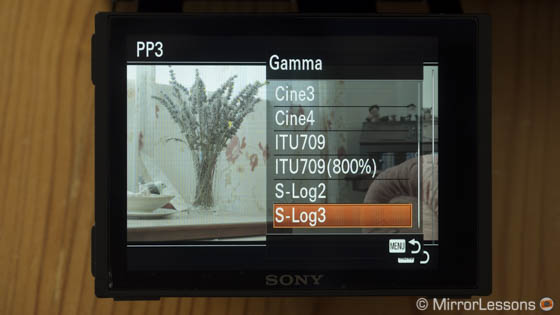
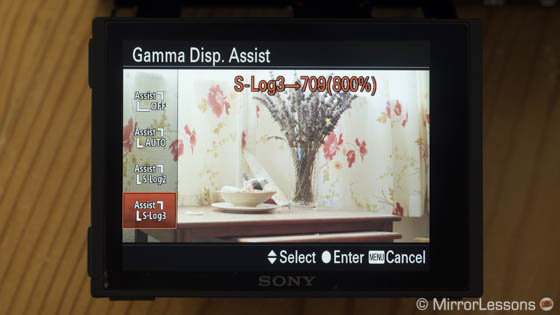
Conclusion

First morning light before returning the camera.
The Sony A7s II is a stunning camera for low-light shooting especially in video mode. The 4K footage is excellent with clean images up to 25600 ISO. Actually I would say that overall this camera produces some of the most beautiful video footage I’ve ever seen from a mirrorless camera regardless of the light conditions. The Picture Profiles help to deliver great results with a more cinematic look in comparison to the Creative Style colour profiles for stills. The original A7s was already successful among filmmakers, and the A7s mark II has followed in its footsteps.
For stills, the performance is very similar concerning image quality. The 12MP sensor produces excellent images with great dynamic range. It’s up to you to decided if the resolution is enough or not. I shot and made large prints with my Nikon D700 six years ago and I wouldn’t hesitate to do it again with the A7s II. The camera also has other useful features such as a silent shutter and internal stabilisation. The ergonomics are good, the level of customisation is not bad with only a few details missing, and the EVF is great. It is a camera that can be very versatile. In fact, the only genre I would exclude is sports. And of course there is the advantage of being able to keep shooting at very high ISOs where other cameras would reach their limit.

The siren lantern rests after the parade ended.
Regarding the last point however, I admit that my personal opinion has changed slightly in comparison to how I felt about the first generation of A7 cameras. The improvements that Sony made to the A7r II make it a more complete camera for photographers. It is not just a matter of pixel count or ISO performance but aspects like the autofocus are also significantly better on the A7r II.
Then comes the question of just how high you need your ISO to go concretely speaking. To me the A7r II is usable up to 12800 and most of the time I find it enough coupled with a fast prime lens. The implementation of the 5-axis stabilisation also helps to push the low-light capabilities further.
So who is the Sony A7s II for then?
Well, in addition to filmmakers, I can see this camera as an excellent second body for someone who already owns another A7 camera or even a DSLR. It can be a great companion for low-light shooting at weddings and events. It can be an excellent tool for macro photography when fast shutter speeds and slow apertures are a necessity. The high ISO capabilities could have great potential for indoor sports as well, where shooting at 12800 or 25600 ISO would allow you to use a faster shutter speed. However the camera’s AF performance lacks in too many ways to be appealing for sports. Phase detection AF would be a welcome addition. I think Sony is missing a niche market in this regard.
 What I like about the Sony A7s mark II:
What I like about the Sony A7s mark II:
- Good ergonomics like the other Mark II cameras
- Good level of customisation
- Excellent EVF (the same as A7r II)
- The most beautiful 4k footage I’ve seen from a mirrorless camera
- Great performance at high ISOs for stills and video
- The best 5-axis stabilisation of all A7 cameras
 What I don’t like about the Sony A7s mark II:
What I don’t like about the Sony A7s mark II:
- A few extra customisation options would be welcome like the ability to start movie recording with the shutter release button
- Focus peaking is not precise enough
- Autofocus can struggle in low light and suffers in video mode
- Metering with ISO Auto is not consistant
- 2.5fps burst with focus priority penalises this camera for sports shooting, a shame given the great high ISO performance (think indoor sports)
- As usual, battery life is pretty poor especially when shooting video
- Very confusing menu system if you are unfamiliar with Sony cameras

